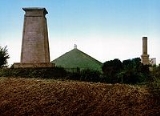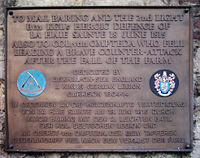
La Haye Sainte
Encyclopedia
La Haye Sainte is a walled farmhouse compound at the foot of an escarpment on the Charleroi-Brussels road. It has changed very little since it played a very important part in the battle of Waterloo
on June 18, 1815. The road leads from La Belle Alliance
, where Napoleon
had his headquarters on the morning of the battle, through where the centre of the French front line was located, to a crossroads on the ridge which is at the top of the escarpment and then on to Brussels. The Duke of Wellington
placed the majority of his forces on either side of the Brussels road behind the ridge on the Brussels side. This kept most of his forces out of sight of the French artillery.
During the night from the 17th to the 18th, the main door to the courtyard of the farm was used as firewood by the occupying troops. Therefore, when the King's German Legion
(KGL) was stationed in the farm at the morning of the battle, they had to hastily fortify La Haye Sainte. The troops were the 2nd Light Battalion KGL commanded by Major Georg Baring
, and part of the 1st Light Battalion KGL. During the battle, they were supported by the 1/2 Nassau Regiment and the light company of the 5th Line Battalion KGL. The majority of these troops were armed with the Baker rifle
, as opposed to the normal Brown Bess
musket of the British Army.
Both Napoleon and Wellington realized the strategic value of the position and it was fought over and around most of the day.
At 13:00, the French Grand Battery of heavy artillery opened fire before d'Erlon's Corps (54th and 55th Ligne) marched forward in columns. The French managed to surround La Haye Sainte and despite taking heavy casualties from the garrison, they attacked the centre left of Wellington's line. As the centre began to give way and La Haye Sainte became vulnerable, Picton's division was sent to plug the gap. As the French were beaten back from La Haye Sainte, the heavy cavalry brigades under Somerset and Ponsonby attacked. This action relieved the pressure on the fortress farm.
At 15:00, Napoleon ordered Marshal Ney
to capture La Haye Sainte. While Ney was engaged in the glorious but futile 8,000 man cavalry attack, unsupported by infantry or cannon, on Allied squares on the Brussels side of the ridge, he failed to take La Haye Sainte.
At 17:30, Napoleon re-issued orders for Ney to take La Haye Sainte. The French had worked up close to the buildings by this time.

 At 18:00 Marshal Ney, heavily supported by artillery and some cavalry, took personal command of an infantry regiment (13th Legere) and a company of engineers and captured La Haye Sainte with a furious assault. "The light battalion of the German Legion, which occupied it, had expended all its ammunition" and had to retreat. Allied forces were unable to counterattack immediately, as they were in squares over the ridge. The French brought up guns to fire from its cover, but riflemen of the 1/95 in the "sand pit" to the east of the farm, picked off all the gunners, so the guns were ineffective.
At 18:00 Marshal Ney, heavily supported by artillery and some cavalry, took personal command of an infantry regiment (13th Legere) and a company of engineers and captured La Haye Sainte with a furious assault. "The light battalion of the German Legion, which occupied it, had expended all its ammunition" and had to retreat. Allied forces were unable to counterattack immediately, as they were in squares over the ridge. The French brought up guns to fire from its cover, but riflemen of the 1/95 in the "sand pit" to the east of the farm, picked off all the gunners, so the guns were ineffective.
At 19:00, thanks to the French garrison in La Haye Sainte, the Imperial Guard was able to climb the escarpment and attack the Allies on the Brussels side of the ridge. This final attack was beaten back and became a rout around 20:10 as the French forces realised that with the arrival of the Prussians from the east, they were beaten. During the French retreat, La Haye Sainte was recaptured by the Allies, some time before 21:00, when Blücher
met Wellington at La Belle Alliance
.
Today, La Haye Sainte is privately owned as a family home. On the walls are memorials to the KGL and the French. Opposite the house is a monument for the officers and the soldiers of the KGL.
Battle of Waterloo
The Battle of Waterloo was fought on Sunday 18 June 1815 near Waterloo in present-day Belgium, then part of the United Kingdom of the Netherlands...
on June 18, 1815. The road leads from La Belle Alliance
La Belle Alliance
La Belle Alliance is an inn situated a few miles south of Brussels in Belgium.On the morning of June 18, 1815 the inn became Napoleon Bonaparte's headquarters for the Battle of Waterloo....
, where Napoleon
Napoleon I of France
Napoleon Bonaparte was a French military and political leader during the latter stages of the French Revolution.As Napoleon I, he was Emperor of the French from 1804 to 1815...
had his headquarters on the morning of the battle, through where the centre of the French front line was located, to a crossroads on the ridge which is at the top of the escarpment and then on to Brussels. The Duke of Wellington
Arthur Wellesley, 1st Duke of Wellington
Field Marshal Arthur Wellesley, 1st Duke of Wellington, KG, GCB, GCH, PC, FRS , was an Irish-born British soldier and statesman, and one of the leading military and political figures of the 19th century...
placed the majority of his forces on either side of the Brussels road behind the ridge on the Brussels side. This kept most of his forces out of sight of the French artillery.
During the night from the 17th to the 18th, the main door to the courtyard of the farm was used as firewood by the occupying troops. Therefore, when the King's German Legion
King's German Legion
The King's German Legion was a British Army unit of expatriate German personnel, 1803–16. The Legion achieved the distinction of being the only German force to fight without interruption against the French during the Napoleonic Wars....
(KGL) was stationed in the farm at the morning of the battle, they had to hastily fortify La Haye Sainte. The troops were the 2nd Light Battalion KGL commanded by Major Georg Baring
Georg Baring
Konrad Ludwig Georg Baring was an officer in the army of the Electorate of Hanover. Some sources also give his name as Baron Georg von Baring.-To 1815:...
, and part of the 1st Light Battalion KGL. During the battle, they were supported by the 1/2 Nassau Regiment and the light company of the 5th Line Battalion KGL. The majority of these troops were armed with the Baker rifle
Baker rifle
The Baker rifle was a flintlock rifle used by the Rifle regiments of the British Army during the Napoleonic Wars. It was the first standard-issue, British-made rifle accepted by the British armed forces....
, as opposed to the normal Brown Bess
Brown Bess
Brown Bess is a nickname of uncertain origin for the British Army's Land Pattern Musket and its derivatives. This musket was used in the era of the expansion of the British Empire and acquired symbolic importance at least as significant as its physical importance. It was in use for over a hundred...
musket of the British Army.
Both Napoleon and Wellington realized the strategic value of the position and it was fought over and around most of the day.
At 13:00, the French Grand Battery of heavy artillery opened fire before d'Erlon's Corps (54th and 55th Ligne) marched forward in columns. The French managed to surround La Haye Sainte and despite taking heavy casualties from the garrison, they attacked the centre left of Wellington's line. As the centre began to give way and La Haye Sainte became vulnerable, Picton's division was sent to plug the gap. As the French were beaten back from La Haye Sainte, the heavy cavalry brigades under Somerset and Ponsonby attacked. This action relieved the pressure on the fortress farm.
At 15:00, Napoleon ordered Marshal Ney
Michel Ney
Michel Ney , 1st Duc d'Elchingen, 1st Prince de la Moskowa was a French soldier and military commander during the French Revolutionary Wars and the Napoleonic Wars. He was one of the original 18 Marshals of France created by Napoleon I...
to capture La Haye Sainte. While Ney was engaged in the glorious but futile 8,000 man cavalry attack, unsupported by infantry or cannon, on Allied squares on the Brussels side of the ridge, he failed to take La Haye Sainte.
At 17:30, Napoleon re-issued orders for Ney to take La Haye Sainte. The French had worked up close to the buildings by this time.


At 19:00, thanks to the French garrison in La Haye Sainte, the Imperial Guard was able to climb the escarpment and attack the Allies on the Brussels side of the ridge. This final attack was beaten back and became a rout around 20:10 as the French forces realised that with the arrival of the Prussians from the east, they were beaten. During the French retreat, La Haye Sainte was recaptured by the Allies, some time before 21:00, when Blücher
Gebhard Leberecht von Blücher
Gebhard Leberecht von Blücher, Fürst von Wahlstatt , Graf , later elevated to Fürst von Wahlstatt, was a Prussian Generalfeldmarschall who led his army against Napoleon I at the Battle of the Nations at Leipzig in 1813 and at the Battle of Waterloo in 1815 with the Duke of Wellington.He is...
met Wellington at La Belle Alliance
La Belle Alliance
La Belle Alliance is an inn situated a few miles south of Brussels in Belgium.On the morning of June 18, 1815 the inn became Napoleon Bonaparte's headquarters for the Battle of Waterloo....
.
Today, La Haye Sainte is privately owned as a family home. On the walls are memorials to the KGL and the French. Opposite the house is a monument for the officers and the soldiers of the KGL.
Sources
- Barbero, Alessandro, The Battle of Waterloo. Walker and Company, 2005, ISBN 0-8027-1453-6.
- Beamish, N. Ludlow, History of the King's German Legion Vol. 2. 1832-37 (reprint: Naval and Military Press 1997 ISBN 0-952201-10-0)
- Chappell, Mike, The King's German Legion (2) 1812–1815. Botley, Oxford: Osprey Publishing, 2000. ISBN 1-85532-997-2
- Hofschröer, PeterPeter HofschröerPeter Hofschröer is a historian who specialises in the Napoleonic Wars. He is a graduate of King's College London and currently lives in Austria....
, The Waterloo Campaign – The German Victory. Greenhill Books London (1999) ISBN 1-85367-368-4
External links
- King's German Legion (in German)
- La Haye Sainte as model

